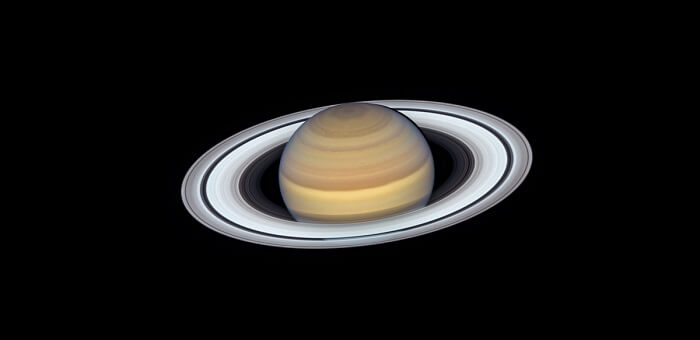Güneş sistemimizde yer alan Saturn gezegeni hakkında ingilizce bilgiler. İngilizce Saturn tanıtımı, özellikleri, gerçekler.

Saturn Hakkında İngilizce Bilgi
Saturn is the sixth planet from the Sun and the most distant that can be seen with the naked eye. Saturn is the second largest planet and is best known for its fabulous ring system that was first observed in 1610 by the astronomer Galileo Galilei. Like Jupiter, Saturn is a gas giant and is composed of similar gasses including hydrogen, helium and methane.
Saturn Planet Profile
- Equatorial Diameter: 120,536 km
- Polar Diameter: 108,728 km
- Mass: 5.68 × 10^26 kg (95 Earths)
- Moons: 62 (Titan, Enceladus, Iapetus & Rhea)
- Rings: 30+ (7 Groups)
- Orbit Distance: 1,426,666,422 km (9.54 AU)
- Orbit Period: 10,756 days (29.5 years)
- Effective Temperature: -178 °C
- First Record: 8th century BC
- Recorded By: Assyrians
Facts About Saturn
Saturn can be seen with the naked eye.
It is the fifth brightest object in the solar system and is also easily studied through binoculars or a small telescope.

Kaynak: NASA
Saturn was known to the ancients, including the Babylonians and Far Eastern observers.
It is named for the Roman god Saturnus, and was known to the Greeks as Cronus.
Saturn is the flattest planet.
Its polar diameter is 90% of its equatorial diameter, this is due to its low density and fast rotation. Saturn turns on its axis once every 10 hours and 34 minutes giving it the second-shortest day of any of the solar system’s planets.
Saturn orbits the Sun once every 29.4 Earth years.
Its slow movement against the backdrop of stars earned it the nickname of “Lubadsagush” from the ancient Assyrians. The name means “oldest of the old”.
Saturn’s upper atmosphere is divided into bands of clouds.
The top layers are mostly ammonia ice. Below them, the clouds are largely water ice. Below are layers of cold hydrogen and sulfur ice mixtures.
Saturn has oval-shaped storms similar to Jupiter’s.
The region around its north pole has a hexagonal-shaped pattern of clouds. Scientists think this may be a wave pattern in the upper clouds. The planet also has a vortex over its south pole that resembles a hurricane-like storm.
Saturn is made mostly of hydrogen.
It exists in layers that get denser farther into the planet. Eventually, deep inside, the hydrogen becomes metallic. At the core lies a hot interior.
Saturn has the most extensive rings in the solar system.
The Saturnian rings are made mostly of chunks of ice and small amounts of carbonaceous dust. The rings stretch out more than 120,700 km from the planet, but are are amazingly thin: only about 20 meters thick.
Saturn has 150 moons and smaller moonlets.
All are frozen worlds. The largest moons are Titan and Rhea. Enceladus appears to have an ocean below its frozen surface.
Titan is a moon with complex and dense nitrogen-rich atmosphere.
It is composed mostly of water ice and rock. Its frozen surface has lakes of liquid methane and landscapes covered with frozen nitrogen. Planetary scientists consider Titan to be a possible harbour for life, but not Earth-like life.
Four spacecraft have visited Saturn.
Pioneer 11, Voyager 1 and 2, and the Cassini-Huygens mission have all studied the planet. Cassini orbited Saturn from July 2004 until September 2017, sending back a wealth of data about the planet, its moons, and rings.
Saturn’s Rings
While all the gas giants in our solar system have rings none of them are as extensive or distinctive as Saturn’s. The rings were discovered by Galileo Galilei 1610 who observed them with a telescope. The first ‘up close’ view of the rings were by Pioneer 11 spacecraft which flew by Saturn on September 1, 1971.
Saturn’s rings are made up of are billions of particles that range in size from tiny dust grains to to objects as large as mountains. These are made up of chunks of ice and rock, believed to have come from asteroids comets or even moons, that broke apart before they reached the planet.
Saturn’s rings are divided into 7 groups, named alphabetically in the order of their discovery (Outwards from Saturn; D, C, B, A, F, G and E). The F ring is kept in place by two of Saturn’s moons, Prometheus and Pandora, these are referred to as ‘shepherd moons’. Other satellites are responsible for creating divisions in the rings as well as shepherding them.
Saturn’s Atmosphere
Saturn’s atmosphere is composed primarily of hydrogen (96%) and helium (3%) with traces of other substances like methane, ammonia, acetylene, ethane, propane and phosphine. Winds in the upper atmosphere can reach speeds of 500 metres a second, these combined with heat rising from within the planet’s interior cause yellow and gold bands.